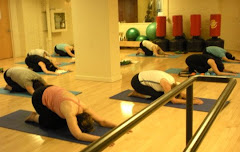
Every muscle in your body is enclosed in a bag of tough connective tissue known as fascia. Fascia is very important for holding your muscles in their proper place in your body. Rich in collagen fibers, it can be a tough, gristly covering, that surrounds every muscle. It forms a vast network throughout the body, surrounding every other cell and continuous from head to toe. It is the white tissue in the pictures shown above. [notice the outstanding form in this disco pose, doesn't even have skin and this cat's look'n great!]
Fascia also includes the tendons that join the muscle to the bone, as well as the joint capsules and the ligaments. Fascia contains numerous nerve fibers and sensory receptors and is better termed, 'neuromyofascia' [not to be confused with leggo-my-eggo] The superficial fascia, directly under the skin, contains adipose tissue and collagenous fibers and is also rich in nerve fibers. This layer is part of holding the twists in the deeper tissues and the counterrotations in our joints. Hence, fascia, is a big part of dancing and full range of motion ih our changing bodies. [does that mean...i am a fasciast?]
Fascia tends to stiffen as we age becoming tight and dried out. If your muscles or bodie is inflamed [feels hot ie: rheumatoid conditions], the body's lubricative material can become glue-like; Once less viscus, the chemistry attracts more inflammatory cells to the area and adheres various layers together.
In general, we can feel "sore" in our fascia, but we may think it's muscle. Or, we may be unable to release all that connective tissue from it's seeminly 'forever-tensed' hold. When healthy, this tight embrace is what we need. When fascia is blocking us from our motion, we have to take slightly more managing steps to help it out.
When your muscles are fully being used, they are pressing against the fascia. When we stretch in class after weight training or dancing, we increase the pressure on the fascia greatly, which can lead to expansion of the fascia.... which give space for your muscles to grow.
When we stretch enough to cause the fascia to expand, we really feel it! When you are stretching the fascia, you feel a powerful pulling sensation and pressure as the muscle works against the fascia to expand it. We rapidly learn to distinguish the difference between a good stretch and a bad stretch. You should not feel sharp pain, just a steady pull. It's sometimes "FIRE-Y" with all those nerves pulling in the tissue. It can feel like we don't even want to breath.
When you stretch sincerely after working the muscle, give your fascia - feedback, or, a reason to expand and release if too small, or tight, or "contracted-tense". It's nice to know that emotional tension, from life, trauma or developmental trauma can really be helped by doing deep fascial and breath work with a good practitioner. My friend and RMT will be dropping a line in here about his work with fascia and helping us work with this amazing part of our bodies.
In general, to expand the fascia, stretches should be 20 to 30 seconds after we have worked them and they are pumped large with blood. However, stretching our bodies is not just about stretching our muscles or flexibility of range of motion. Breathing into every stretch changes our body in shape, in detoxification, in oxigen uptake, and our relationship to our connective nature.
Don't by shy to admit to yourself, that you dont' like stretching or that it's painful. let's just do it slowly, carefully, together.
I am currently teaching private/public Acuball Release classes at the Miles Nadel JCC at Bloor and Spadina in Toronto. You can find out my schedule by looking up www.dancefitschedule.blogspot.com (yes a website will be created soon)
My Friend Marla Gold, who also teaches Acuball classes says "releasing tension in the body on a regular basis is so important to keep us mobile, happy beings" she adds, "it's important for people to practice self-agency in this process." Marla and I both advise that while receiving asstance for fascial release is healthy, and active stretching works, options like the ball offers deep tissue accessibility that you sense actively - feedbacking into the very same body you need to heal. As movement and health practicionners, if we don't understand restoration and feedback systems, we just don't have, not just the language, but the teachings to help ourselves, and help others. For me, the acuball is part of our heal-theyself personal program done alone or in community groups. Special thanks to Canadian chiro Michael Cohen for creating this wonderful tool, affordable, heatable and accessible. Its used by the NHL, Olympians, and soon .... by many of us in living embodied and in motion.
*Body facts+Source - Nick Nilsson
* http://www.rolfingseattle.com/aboutfascia.html
* http://www.body-rhythms.com
* http://www.acuball.com








No comments:
Post a Comment